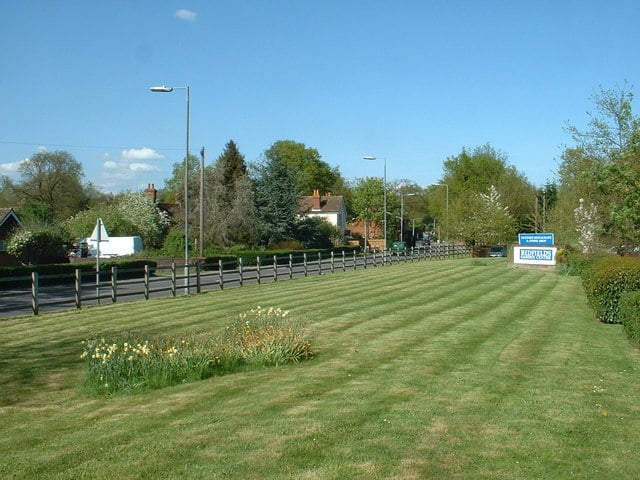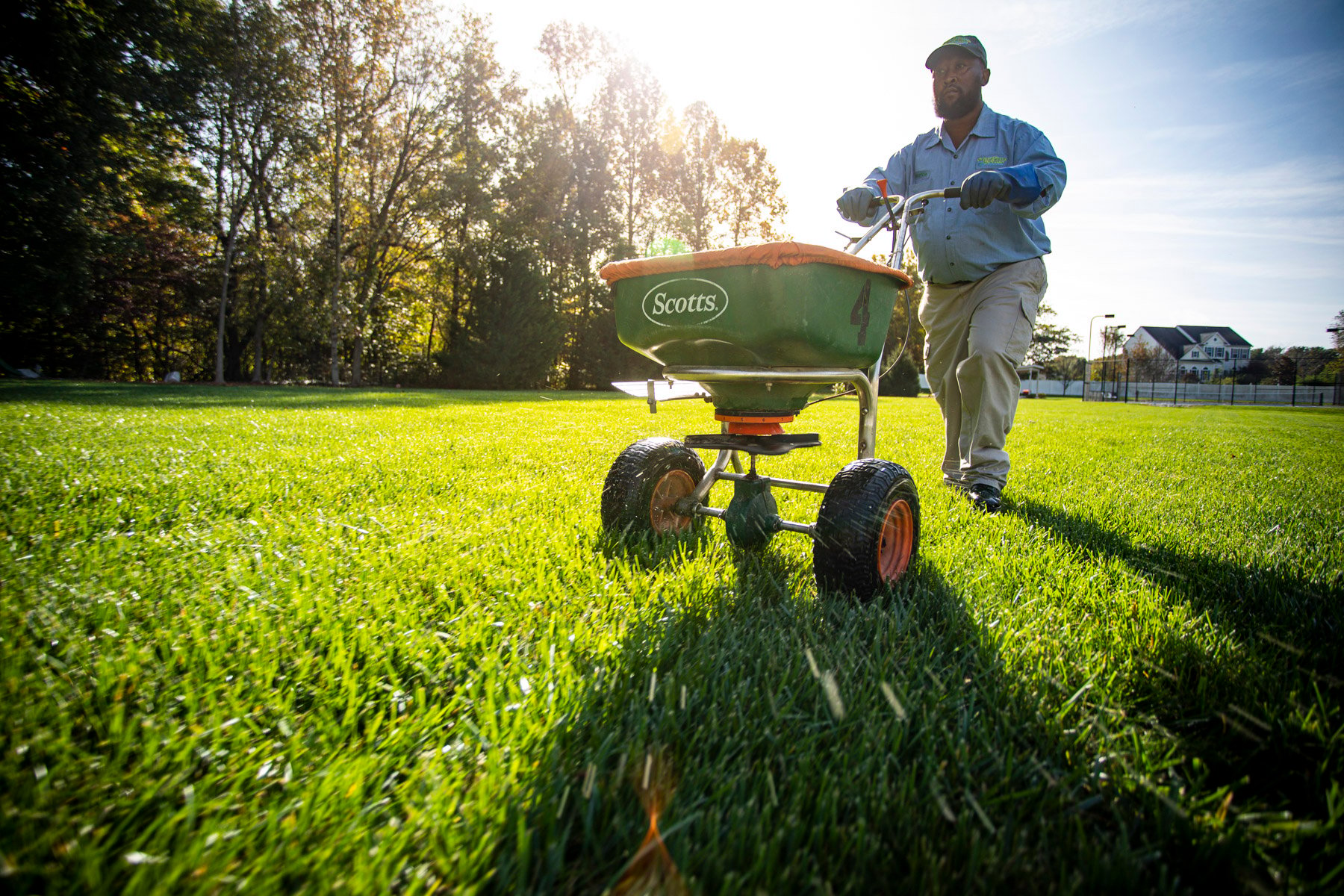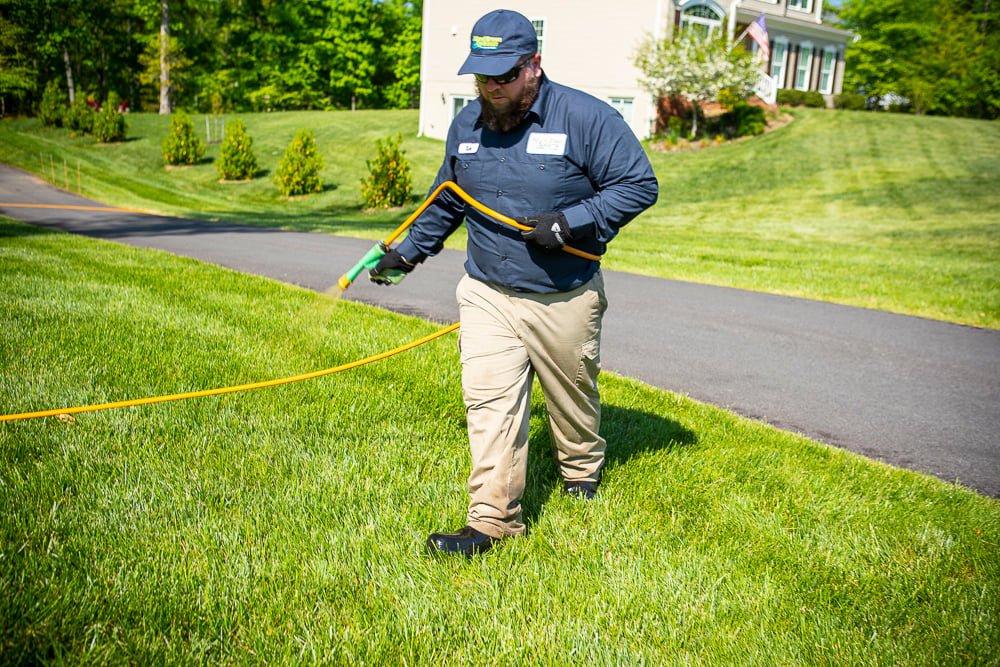How to Identify and Get Rid of Brown Patch Disease in Your Maryland Lawn
Traditionally, lawns are more enjoyable if they are green.
Clearly, brown spots are not invited. They aren’t pretty. They are basically a sign that something is wrong. If you see some brown or dead bits in your lawn, you’re probably thinking it needs a little water. Or maybe it needs some sunlight.
But what may be happening is you’ve got something that you didn’t welcome in your lawn. In fact, there’s a fungus among us. You’ve got brown patch lawn disease.
Hot and humid weather conditions create the perfect breeding ground for the fungus to cause your lawn to decline.
Let’s take a closer look at this common lawn disease and talk about the best ways to get rid of it.
Brown Patch Lawn Disease 101
Brown patch, though common in Central and Southern Maryland, doesn’t always quickly reveal its existence.
In fact, the first signs of trouble can resemble other types of lawn problems like drought, other diseases, or even other types of damage from insect or nutrient deficiencies.
That’s why learning how to get rid of brown patch fungus means learning all you can about the disease itself.
What is Brown Patch?
Brown patch is a summer lawn disease caused by a fungus called Rhizoctonia.
It can impact cool-season grasses, being most tough on tall fescue and perennial ryegrass, as well as warm-season grasses, including St. Augustine grass.
The appearance of brown patch lawn disease can vary, making it a tricky one to identify. But, generally, you will see yellow or brown grass patches that are in roughly circular shapes, ranging between 1 to 3 feet in diameter. The border of these disease circles will usually be darker in color.  When you look closely at the individual grass blades, you’ll see tan, irregular lesions. Since brown patch is a foliar disease, this means it just harms the grass blades and not the root system.
When you look closely at the individual grass blades, you’ll see tan, irregular lesions. Since brown patch is a foliar disease, this means it just harms the grass blades and not the root system.
When Does Brown Patch Appear?
In Central and Southern Maryland, you will typically start to see brown patch lawn disease in mid-to-late May.
The real drivers are high daytime temperatures in the 80s or 90s coupled with high humidity followed by high nighttime temperatures around 70 degrees paired with lingering humidity.
Where Will You Typically Find Brown Patch?
In addition to those conditions that cause brown patch lawn disease to appear, there are also some areas that tend to be more sensitive to its spread.
Poor air flow will exacerbate high temperatures and humidity. For instance, if your property is surrounded by woods or if you have a fenced-in yard -- any areas where there is a break in air circulation -- you’ll likely find more brown patch in these spots.
Periods of rainy weather during humid days can also promote the appearance of brown patch. Things that accelerate this include poor soil drainage, compact soils, excessive thatch, and poorly maintained lawns.
How to Get Rid of Brown Patch Fungus
Mother nature delivers some conditions like high temperatures and humidity without your consent or permission. So these factors are beyond your control.
But there are other things you can do to limit the chances of brown patch taking over your lawn.
Good Lawn Care
Since the right conditions can strike at any time to bring about this fungus, embracing preventive measures is an important strategy to curb its spread.  You’d be surprised at what taking care of your lawn can do to limit problems down the road.
You’d be surprised at what taking care of your lawn can do to limit problems down the road.  Here are some basic things you should remember to do to minimize the likelihood of brown patch lawn disease:
Here are some basic things you should remember to do to minimize the likelihood of brown patch lawn disease:
- Water properly. Water early in the day so your grass can dry out before nightfall.
- Boost air circulation. Annual aeration each fall can improve airflow and reduce that hanging humidity that causes disease. Partnering this with overseeding can help thicken up any bare or thin areas, making them stronger.
- Fertilize correctly. Fertilizing with the right doses of nutrition each year helps your lawn fight diseases. Avoid over-fertilizing.
- Mow right. Never over-mow a lawn since it could cause additional stress. Your lawn should always stand nice and thick at about 3.5 to 4 inches tall.
Treat Brown Patch Fungus
While many lawns can recover from brown patch without fungicide applications, brown patch disease treatment might be necessary. This is especially true if you tend to see the fungus over and over again or have a yard that is conducive to the conditions the disease likes, such as one with poor air circulation. If you have a lawn that gets a lot of shade during the day and only a bit of sun at night, you may also find this is a place where brown patch can regularly erupt.
And, let’s face it, Central and Southern Maryland summers are known to be hot and humid. As such, 80 percent of lawns here experience some kind of lawn disease.
If you’ve tried good lawn care and still have issues or notice you have an annual brown patch problem, consider lawn disease control. Fungicide treatments are an addition to your current lawn care program. They are most effective when done in a minimum of two treatments, but preferably three to four, through the growing season when you first see the disease. Preventive fungicide applications are the best way to treat brown patch fungus, which means catching it and attacking it early.
A Disease-Free Maryland Lawn in Possible
Now that you have the knowledge about how one of Maryland’s worst lawn diseases operates and you know how to fight it, it’s time to prepare for a great summer outside.
Worried your lawn spots are not brown patch lawn disease? Or maybe you can’t seem to get a handle on your increasing bare areas and dead patches.
We understand. People study lawn diseases for years and still have trouble distinguishing between them. Let Natural Green help. We know Maryland lawns, and so we know where and when brown patch strikes. And we can get rid of it so you can get your thick, green lawn back.
Is brown patch making you see spots? We’d love to help. Get started today with a free quote. Together, we’ll prepare a customized plan for your Central or Southern Maryland lawn so you can make an educated decision.
Image Source: Brown Patch, Brown patch 2
Traditionally, lawns are more enjoyable if they are green.
Clearly, brown spots are not invited. They aren’t pretty. They are basically a sign that something is wrong. If you see some brown or dead bits in your lawn, you’re probably thinking it needs a little water. Or maybe it needs some sunlight.
But what may be happening is you’ve got something that you didn’t welcome in your lawn. In fact, there’s a fungus among us. You’ve got brown patch lawn disease.
Hot and humid weather conditions create the perfect breeding ground for the fungus to cause your lawn to decline.
Let’s take a closer look at this common lawn disease and talk about the best ways to get rid of it.
Brown Patch Lawn Disease 101
Brown patch, though common in Central and Southern Maryland, doesn’t always quickly reveal its existence.
In fact, the first signs of trouble can resemble other types of lawn problems like drought, other diseases, or even other types of damage from insect or nutrient deficiencies.
That’s why learning how to get rid of brown patch fungus means learning all you can about the disease itself.
What is Brown Patch?
Brown patch is a summer lawn disease caused by a fungus called Rhizoctonia.
It can impact cool-season grasses, being most tough on tall fescue and perennial ryegrass, as well as warm-season grasses, including St. Augustine grass.
The appearance of brown patch lawn disease can vary, making it a tricky one to identify. But, generally, you will see yellow or brown grass patches that are in roughly circular shapes, ranging between 1 to 3 feet in diameter. The border of these disease circles will usually be darker in color.  When you look closely at the individual grass blades, you’ll see tan, irregular lesions. Since brown patch is a foliar disease, this means it just harms the grass blades and not the root system.
When you look closely at the individual grass blades, you’ll see tan, irregular lesions. Since brown patch is a foliar disease, this means it just harms the grass blades and not the root system.
When Does Brown Patch Appear?
In Central and Southern Maryland, you will typically start to see brown patch lawn disease in mid-to-late May.
The real drivers are high daytime temperatures in the 80s or 90s coupled with high humidity followed by high nighttime temperatures around 70 degrees paired with lingering humidity.
Where Will You Typically Find Brown Patch?
In addition to those conditions that cause brown patch lawn disease to appear, there are also some areas that tend to be more sensitive to its spread.
Poor air flow will exacerbate high temperatures and humidity. For instance, if your property is surrounded by woods or if you have a fenced-in yard -- any areas where there is a break in air circulation -- you’ll likely find more brown patch in these spots.
Periods of rainy weather during humid days can also promote the appearance of brown patch. Things that accelerate this include poor soil drainage, compact soils, excessive thatch, and poorly maintained lawns.
How to Get Rid of Brown Patch Fungus
Mother nature delivers some conditions like high temperatures and humidity without your consent or permission. So these factors are beyond your control.
But there are other things you can do to limit the chances of brown patch taking over your lawn.
Good Lawn Care
Since the right conditions can strike at any time to bring about this fungus, embracing preventive measures is an important strategy to curb its spread.  You’d be surprised at what taking care of your lawn can do to limit problems down the road.
You’d be surprised at what taking care of your lawn can do to limit problems down the road.  Here are some basic things you should remember to do to minimize the likelihood of brown patch lawn disease:
Here are some basic things you should remember to do to minimize the likelihood of brown patch lawn disease:
- Water properly. Water early in the day so your grass can dry out before nightfall.
- Boost air circulation. Annual aeration each fall can improve airflow and reduce that hanging humidity that causes disease. Partnering this with overseeding can help thicken up any bare or thin areas, making them stronger.
- Fertilize correctly. Fertilizing with the right doses of nutrition each year helps your lawn fight diseases. Avoid over-fertilizing.
- Mow right. Never over-mow a lawn since it could cause additional stress. Your lawn should always stand nice and thick at about 3.5 to 4 inches tall.
Treat Brown Patch Fungus
While many lawns can recover from brown patch without fungicide applications, brown patch disease treatment might be necessary. This is especially true if you tend to see the fungus over and over again or have a yard that is conducive to the conditions the disease likes, such as one with poor air circulation. If you have a lawn that gets a lot of shade during the day and only a bit of sun at night, you may also find this is a place where brown patch can regularly erupt.
And, let’s face it, Central and Southern Maryland summers are known to be hot and humid. As such, 80 percent of lawns here experience some kind of lawn disease.
If you’ve tried good lawn care and still have issues or notice you have an annual brown patch problem, consider lawn disease control. Fungicide treatments are an addition to your current lawn care program. They are most effective when done in a minimum of two treatments, but preferably three to four, through the growing season when you first see the disease. Preventive fungicide applications are the best way to treat brown patch fungus, which means catching it and attacking it early.
A Disease-Free Maryland Lawn in Possible
Now that you have the knowledge about how one of Maryland’s worst lawn diseases operates and you know how to fight it, it’s time to prepare for a great summer outside.
Worried your lawn spots are not brown patch lawn disease? Or maybe you can’t seem to get a handle on your increasing bare areas and dead patches.
We understand. People study lawn diseases for years and still have trouble distinguishing between them. Let Natural Green help. We know Maryland lawns, and so we know where and when brown patch strikes. And we can get rid of it so you can get your thick, green lawn back.
Is brown patch making you see spots? We’d love to help. Get started today with a free quote. Together, we’ll prepare a customized plan for your Central or Southern Maryland lawn so you can make an educated decision.
Image Source: Brown Patch, Brown patch 2
Share This
Topics: Lawn Care


